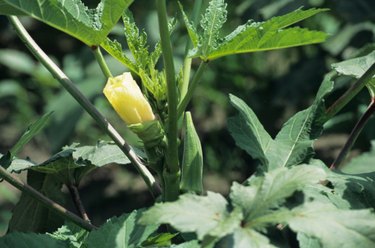
A staple in many Southern gardens due to its ability to withstand extreme heat, okra is a versatile vegetable used in soups, stews and gumbo, as well as baked, steamed, fried, boiled, grilled or pickled. Grown for its fleshy seedpods, okra doubles as an ornamental plant. As a member of the Malvaceae family, which includes hibiscus and hollyhock, okra grows 6 feet or taller while blooming big, beautiful yellow flowers. Okra is an easy and prolific vegetable to grow with only a few garden pests.
Stinkbugs
Video of the Day
Deformed buds, flowers and seedpods, premature bud drop and seedpods with hard callused bumps are signs of a stinkbug problem. There are several species of stinkbugs, the most common being the green stinkbug, harlequin bug, Southern green stinkbug and consperse stinkbug. They are approximately 1/2 inch long and are green or brown. Harlequin bugs are black and red. Handpick these bugs but wear gloves because they release a foul odor when disturbed or handled. For infestations, use pyrethrin, which is a plant compound found in daisies. Wear gloves when handling pyrethrins and follow the label directions.
Video of the Day
Caterpillars and Cabbage Worms
A variety of different caterpillars and cabbage worms feed on okra foliage. Cabbage worms especially are very destructive and can destroy an entire crop. Handpick caterpillars and cabbage loopers. Using parasitic wasps that feed on caterpillars and cabbage worms is another option. For serious problems, spray okra plants with Bacillus thuringiensis kurstaki. BTK is a microbial biological control method that paralyzes and kills a variety of caterpillars and cabbage worms. After the insect ingests the poison, it may live for a few more days, but it stops feeding and dies.
Aphids
Aphids are small, pear-shaped insects with wide range of colors including red, orange, yellow, green, brown, black, white and grey. Colonies form and suck the sap from okra leaves. Their feedings cause leaf, bud and flower distortions. They secrete a sticky substance called honeydew that attracts other insects and grows sooty mold. A strong stream of water knocks the aphids off the okra plant. Attract native predators by planting pollen and nectar plants. Parasitic wasps and lacewings feed on the aphids. Use neem oil or insecticidal soap made from water and a dollop of mild dish soap.
Japanese Beetle
Japanese beetle feed on okra's seedpods and skeletonize the leaves. Adults are stout and metallic blue-green with bronze wing covers and long legs. Spread a light colored cloth around the base of the okra plant in the early morning and shake the plant firmly but gently. The beetles fall onto the cloth. Collect and drown them in soapy water. Use insecticidal soap or neem oil as a last resort.